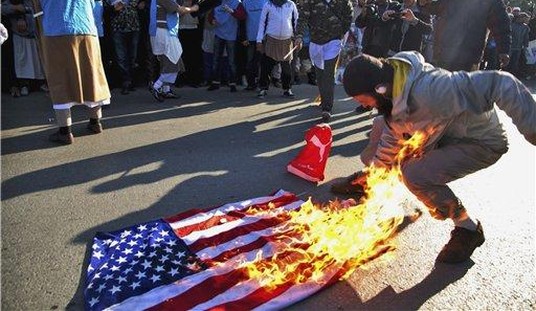Back in November, I interviewed Rob Long for PJM Political. Rob, as you probably already know, is the former Cheers producer who writes a weekly column for National Review and contributes from time to time at PJTV. (He also has a blog that’s well worth your time, here.) We conducted the interview in one of the luxurious bars of the MS Eurodam while the cruise ship was docked in San Juan, PR in the midst of the National Review Caribbean cruise.
As Rob wrote in a recent column, (available to NR subscribers here, and to non-subscribers, at least at the moment, here) immediately after this very plush voyage, he took a cruise of a different sort. Rob hopped aboard the Hanjin Miami, a 90,000-ton container ship bound from Seattle to Shanghai. Rob chose the 16-day voyage aboard the enormous, but spartan vessel to block himself off from emails, cell calls, IMs, Tweets, and all of the myriad of electronic distractions that get in the way of grinding out big chunks of sustained, meaty writing. (See also: blogging.)
His voyage on the Hanjin Miami ended up being extended a week more than he planned, due to the then nascent economic slowdown:
If the world is flat, it’s not because of the Internet. It’s because of shipping companies like Hanjin, which can haul containers filled with tens of thousands of flat-screen TVs from the ports of China to the port of Long Beach, Calif., load the containers onto trucks or trains, and have the flat screens on the shelves of your local Wal-Mart in a few days.
And that’s pretty much where the global supply chain peters out. The containers that were stacked so high and deep on the Hanjin Miami as we made our stormy way from Seattle to Shanghai were empty. That’s what we send back to China: empty containers. They send us extruded plastic doodads and TVs and blue jeans, and we send them empty boxes to refill and resend. They make stuff to wear and use, and we make credit-default swaps.
When the weather got nice, I walked along the outside deck — yes, yes: I did some writing, too; stop nagging me — and looked at the rows and rows of empties. Some weren’t empty, of course: The “reefers,” or refrigerated units, carried frozen fish and lobster, and one or two of the containers were marked “contains American hay,” which is not something I ever thought might be a major export.
But what started as a writer’s retreat, a way to trick myself into finishing a troublesome script, became instead a front-row seat to the world’s economic slump. America doesn’t make; it buys. And when America stops buying, the whole system shuts down. Outside of Shanghai harbor, anchored in a miles-long watery parking lot, were hundreds of container ships waiting for orders, killing time until there was a reason to head into port. If Wal-Mart doesn’t expect much demand, the message goes out to the masters of every container ship plying the water between China and the United States: Don’t hurry back. So they don’t. They sit at anchor and wait for better times.
And as the maritime-oriented Website Lloyd’s List noted last week in an article titled, “Toyota charters vessel to store unsold cars”, that’s exactly the strategy the car marker is employing, as their industry heads in the same direction the Dow is currently racing:
CAR manufacturer Toyota has so many unsold cars it has had to charter a ship to store them all.
Toyota said today it had chartered a 2,500-capacity vessel which will simply stand idle in port in Malmo, Sweden.
The vessel, belonging to car-carrier specialist Wallenius Wilhelmsen, is necessary because there is simply no more room to store cars at the Toyota import site in Malmo, the company said.
“We have space for 12,500 cars in Malmo, which acts as a distribution centre for all the Nordic countries,” said Toyota spokesman Etienne Plas. “But we have run out of space. We need the ship to store cars while they are waiting to be delivered. Hopefully we won’t need it for that long.”
The Japanese giant, which is expected to report its first ever loss this year, saw exports drop almost 60% in January. All manufacturers have seen a similar slump in demand since the credit crunch hit.
I wonder how many container ships–with or without cargo–are waiting offshore, or docked with massive amounts of cargo that, at least for the moment, is largely unsellable. In Toyota’s case, it probably beats getting clobbered with import taxes and the like on merchandise that likely won’t be moving soon.










Join the conversation as a VIP Member